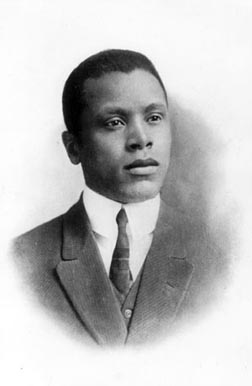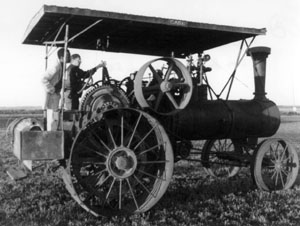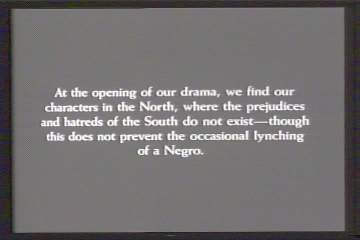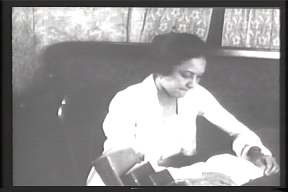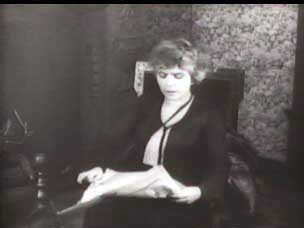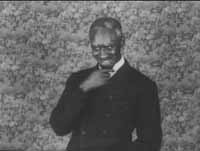Within Our Gates.
Part 1
|
Micheaux produced his films during a time of great change in the African American community. The economic opportunities made available to black workers during World War I prompted a large migration from the rural South to the industrial North: between 1917 and 1920, high paying urban jobs induced 700,000 to 1,000,000 African Americans to leave the poverty and semi-feudal conditions of the South. Another 800,000 to 1,000,000 African Americans left during the decade of the 1920's. While the pre-war migration of blacks had primarily been to southern urban areas, the new migration was to northern cities such as Detroit, Chicago, and New York City.[1] In 1917, W.E. B. DuBois wrote in the magazine The Crisis, "As to the reasons of the migration, undoubtedly, the immediate cause was economic, and the movement began because of floods . . . [and] the boll weevil. [In] back of them is, undoubtedly, the general dissatisfaction with the conditions in the South." Du Bois had heard the new migrants' grievances, which included the inability to vote, the fear of lynching, "bad treatment," lack of education, and discrimination.[2]
Besides higher wages, the North also promised the franchise and better social conditions. The concentration of large numbers of African Americans in northern cities aided in the proliferation of self-help organizations such as the Urban League, the National Association for the Advancement of Colored People (NAACP) and the Negro Business League. It also fueled artistic movements such as the Harlem Renaissance. Large urban African American communities provided the audiences for motion picture directors such as Oscar Micheaux.
Micheaux was born in Metropolis, Illinois in 1883, one of the first generation of African Americans born into freedom. His father was a farmer and his mother was a schoolteacher. They implanted three ideas in the young boy's mind that would be valuable messages of his own—the importance of owning your own land, respect for farming as a profession, and the value of education.[3]
|
Three years later, in 1913, Micheaux wrote and published his first novel, The Conquest. With a limited education, and largely self-taught, Micheaux began writing as a form of thereapy, according to Henry T. Sampson.[5]. After the publication of The Conquest, Micheaux switched careers, believing he could earn a living as a novelist. In the following four years, and before his filmmaking debut, he published two more novels, The Forged Note (1915) and The Homesteader (1917). Both books drew heavily upon his experiences in Chicago and on the farm in South Dakota. The novels were partially autobiographical. Micheaux was learning to manipulate the material of his life for creative purposes, rewriting his own biography to illustrate his philosophies on manhood and race.
The popularity of The Homesteader eventually attracted the attention of George P. Johnson, booking manager of the Lincoln Motion Picture Company, a successful black film production company. The Lincoln Company expressed interest in filming the novel but during negotiations Micheaux decided he should supervise the motion picture production in Los Angeles. This was not acceptable to the Lincoln management and ultimately led to the formation of the author's own firm, the Micheaux Film and Book Company.
Throughout the silent era, Micheaux created cinematic portrayals of African American manhood that stood in sharp contrast to Hollywood's depictions. Mainstream film companies portrayed black men largely as humorous objects—dim witted, slow moving, shiftless caricatures who would not threaten mainstream audiences. Most black-owned film companies of the post-World War I era�including the Frederick Douglas Film Corporation, the Unique Film Company, and the Rosebud Film Corporation�presented African American men as embodiments of good and evil, either as epitomes of virtue or dastardly ogres.[6] While these companies attempted to illustrate desirable characteristics of black manhood, they did so in unrealistic ways that did not consider the economic, political and social frustrations that African American men faced on a daily basis. Thus, saint-like figures proved to be impossible role models for urban or rural African Americans.
In his novels as well as his films, Micheaux attempted to demonstrate the qualities needed to be a successful black man. He had written, in The Homesteader, "[The] race needed examples; they needed instances of successes."[7] But Micheaux also explored the motivation behind the negative characteristics of some African American men. As bell hooks argues, "He was not concerned with a simple reduction of black representation to a positive image."[8] All the dirty laundry of African American masculinity was aired in Micheaux's cinema: gambling, drugs, passing for white, conspiring with white men for selfish advancement, and criminality. Oscar Micheaux was unique among African American filmmakers in resisting the idealization of black manhood that was so common in the work of his peers. He called upon African American men to question their own activities and morals, warts and all.
Two themes—the exposure of racial hostility and prejudice toward African Americans, and alternative depictions of black manhood—were most prominent in Micheaux's second film, Within Our Gates, one of his most provocative and scandalous. Released shortly after a summer of race riots in 1919 and criticized by segments of both the black and white communities, the film had numerous problems with the censors.[9]
A single surviving print of the film was found in Spain in the 1980's, retitled La Negra. The original English intertitles were lost, except in four cases. The film has since been restored by the Library of Congress but the intertitles on the restoration only approximate Micheaux's originals.Translated back into English from the Spanish translations, the original African American syntax and slang were lost in the new version.[10] The discovery of Within Our Gates is significant because it remains the oldest surviving example of African American feature filmmaking. It is also critical to understanding Micheaux's oeuvre because of the many ways he reworked the film after its original release.[11]
The print of Within Our Gates now available to the public is not the original film which Micheaux screened for film audiences in January 1920. The surviving print is remarkably radical considering contemporary cinematic discourse among African American filmmakers of the era. As Micheaux scholar Jane Gaines has noted, censors objected to D. W. Griffith's The Birth of a Nation because it told a completely fabricated version of American history. Within Our Gates, on the other hand, was criticized and censored because it told too much truth.[12] Because the filmt stood as a counterpoint to Birth of a Nation and because it so powerfully presented Micheaux's view of black manhood, a detailed analysis of Within Our Gates helps establish Micheaux's significant contributions to American cinema, African American cinema, and our understanding of changing portrayals of black manhood in film.
|
|
The first half of the film centers on Piney Woods, "far from all civilizations and in the depth of the forests of the South where ignorance and the lynch law reign supreme." Micheaux clearly points out the geographic distinctions in racial prejudice in the United States. While Micheaux encouraged African Americans to migrate west rather than north, he clearly illustrated the racial hostility blacks faced in the South.
The viewer is soon introduced to Reverend Wilson Jacobs, the founder of a school for African Americans and "[an] apostle of education for the black race." Micheaux demonstrates the lack of educational opportunities available to African American children in the South. Shortly after Sylvia arrives in Piney Woods, intertitles explain the challenges Reverand Jacobs and Landry face—reaching and teaching others who arrived at Piney Woods, "others . . . who could not read." A dark-skinned farmer and his two small children walk into Reverend Jacobs' office. The farmer explains that boll weevils have eaten up his cotton crop (a very real problem in the 1910's) and since he could not pay his rent, his mule has been taken away. He explains further, "I hears 'bout your school 'n so we walked from my place, aways off, cause my children don't do nothin' but say 'Papa without schoolin' we c'n never mount to nothin.' So her I is, ready to work day n'night so's my children can go to school." Micheaux does not use dialect in order to be derogatory, but to express the desire of a poor, uneducated sharecropper to provide his children with the means to a better life than his own. The scene is unique in films produced both by white and black filmmakers of the period. Many whites believed that African-Americans were too lazy or stupid to want an education. While other African American filmmakers ridiculed the poor black southerner, Micheaux held him up as a model.[15]
Reverend Jacobs explains to Sylvia that the school is nearly out of money. New students are turned away every day because of the lack of funds. Sylvia decides that she must raise money for the school. With her bags packed, she tells Wilson, "It is my duty and the duty of each member of our race to destroy ignorance and superstition." The film then introduces Dr. V. Vivian (Charles Du Lucas), a man "passionately engaged in social questions," who is about to meet Sylvia while rescuing her from a thief.[16] He is reading the Literary Digest and the camera focuses on the passage in front of him, as it does several times in the course of the film, revealing Micheaux's point of view. The passage reads: "Reverend Thurston has begun an active campaign for the education of the black race. He asks that the federal government contribute significantly, so that Negro children in all of the U.S. can receive proper instruction." Thus, Micheaux addresses a serious contemporary problem which virtually all filmmakers of the period, both black and white, ignored.
|
Sylvia has little luck raising funds until she quite accidentally meets a wealthy white female philanthropist, Mrs. Elena Warwick, who hits her with her automobile! Sylvia explains the financial crisis of the Piney Woods school. Mrs. Warwick solicits the advice of Geraldine, who offers a number of reasons why it is foolish for Mrs. Warwick to donate money for black education. She insists that black men are nothing more than "lumberjacks and field hands" and claims "thinking would only give them a headache." This white bigot represents traditional racist arguments which support discrimination and prejudice. Micheaux is quite subversive here by making Geraldine an object of ridicule. As a symbol of Southern bigotry she is the "irregular" member of the cast. Geraldine suggests to Mrs. Warwick that rather than spend $5000 on black education she should give $100 to Old Ned "the best colored preacher in the world." "Old Ned will do more to keep the Negroes in their place than all your schools put together," Geraldine explains.
At this stage in the film, there is a five-minute segment criticizing Old Ned and the black religious community. Micheaux viewed traditional black religiosity (and the men who disseminated its dogma) as dangerous to the freedom and advancement of African Americans. Members of black churches complained bitterly about these depictions. Old Ned is clearly an Uncle Tom but he is not an evil man. In fact, Micheaux goes to great lengths to make him a tragic figure trapped by the racial system in which he lives. Ned preaches to his congregation that "white folks, with all their schooling, all their wealth, will most all fall into the everlasting inferno, while our race, lacking these vices and whose souls are more pure, most all will ascend to heaven."
|
Old Ned justifies the present racial system as God's ordained plan. Being poor and uneducated are attributes which will lead African Americans into heaven. He meets his white acquaintances, who ask him, "What do you make of this? It's about the negroes' right to vote." We are all in favor of your people but we ain't be having' negroes voting." Being a "good old colored man," Ned answers, "Y'all know what I always preach. This is a land for the white man and black folk got to know their place." The two middle-aged white men clap and Old Ned begins an emotional sermon. He does not need politics or wealth—all he needs is Jesus. Even though Old Ned argues that the majority of white people will go straight to hell while most black people will go to heaven, the white men only support his religious views. They do not challenge him because they understand that this black religious doctrine tolerates the current racial and social system. Black religion, therefore, is a means of control—a way of keeping black men in their place. In a humiliating move, one of the white men kicks Ned in the rear end and makes a fool of him as he responds, "Yess'm. White folks is mighty fine."
What follows is one of the most poignant scenes of the film. Old Ned closes the door and turns from a smiling, grinning buffoon to a disgusted black man. It has all been a performance. Old Ned says to the camera, "Again, I've sold my birthright. All for a miserable mess of pottage." Despondent and frustrated, he argues, "Negroes and Whites - all are equal. As for me miserable sinner, hell is my destiny." This is a remarkably provocative scene. Uncle Tom characters were a staple in white mainstream films and some black independent productions, but never had a director attempted to explain the psychology of such a human being. As Old Ned chastises himself, Micheaux implies that this character is less than a man. Cultural historian Lawrence Levine shows in Black Culture and Black Consciousness that the voices and faces that African Americans revealed to whites seldom reflected their own self-conceptions or identities. Their complex psychic negotiations are beautifully captured in a song sung by generations of African Americans: "Got one mind for white folks to see, 'Nother for what I know is me; He don't know, he don't know my mind."[18]
- Joe Trotter, "Migration," Encyclopedia of African
American Culture and History, volume 4, Eds. Salzman, Smith,, West.
(New York: Simon and Schuster, 1996), 1781. [Return]
- Crisis (June 1917). [Return]
- Henry T. Sampson, Blacks in Black and White: A Source Book on Black Film (New York: Scarecrow, 1995), 142-143. [Return]
- Apparently, Reverend McCracken's actions and character totally infuriated Micheaux. Despicable ministers, most likely modeled after his father-in-law, would appear in a number of his films. [Return]
- Sampson, Blacks in Black and White, 146. [Return]
- Gerald Butters, "Portrayals of Black Masculinity in American Silent Film, 1896-1929" (Ph.D. Diss., University of Kansas, 1999), 185-229. [Return]
- Oscar Micheaux, The Homesteader (College Park: McGrath Publishing, 1969), 109. [Return]
- Bell Hooks, "Micheaux: Celebrating Blackness." Black American Literature Forum 25(Summer 1991): 351-360. [Return]
- The eight-reel film was produced in 1919 and released in Chicago and Detroit in January, 1920. [Return]
- Preface to restored version of Within Our Gates (Washington, D.C.: Library of Congress). [Return]
- Bernard L. Peterson, Jr., "The Films of Oscar Micheaux: America's First Fabulous Black Filmmaker." The Crisis 86 (April 1979), 138. [Return]
- Jane Gaines, "Race, Melodrama and Oscar Micheaux" in Black American Cinema,Ed. Manthia Diawara (New York: Routledge, 1993), 50. [Return]
- W. Fitzhugh Brundage, Lynching in the New South (Urbana: University of Illinois Press, 1993), 8. [Return]
- William Tuttle, Race Riot: Chicago in the Red Summer of 1919 (New York: Antheum Press, 1970), 14-15. [Return]
- A number of African American directors of the silent era ridiculed the rural black population. Uncle Remus's First Visit to New York (Hunter Haynes Photoplay Company, 1914) involved the title character and his wife who, inexperienced in the ways of modern life, suffer a series of misadventures in New York City. In Why Worry (Lone Star Motion Picture Producers, 1923) the leading characters are also "dumb rural hicks" who come to the big city. [Return]
- Lucas also starred in Micheaux's first film, The Homesteader. A very light-skinned, handsome leading man with "good" hair and a strong physique, he was the classic Micheaux hero figure. [Return]
- Joel Williamson, The Crucible of Race: Black-White Relations in the American South Since Emancipation (New York: Oxford University Press, 1984), 379. [Return]
- Lawrence W. Levine, Black Culture and Black Consciousness (New York: Oxford University Press, 1977), xiii. [Return]
~ Continued in Part 2 ~ Homestead to Lynch Mob: Portrayals of Black Masculinity.
Copyright © 2000, 2001 by The Journal for MultiMedia History
Comments | JMMH Contents - Crisis (June 1917). [Return]
